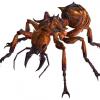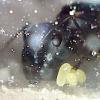Depends on the species, and even then it varies from queen to queen.
Semi-claustral obviously need food regularly. With as little disturbance as possible.
Some like Formica, prefer to be left alone until they have workers.
Others, like my Camponotus herculeanus, welcomed a slight interruption if food was also offered.
None of my queens like larger vibrations, and most did not like my shadow falling over them. They did not care about light, but didn't like my shadow.
Some of my species did not like any kind of food, while others ate at every opportunity.
In other words, ants are like people. You will never get them all to agree to one thing. Treat each one uniquely as to their preferences. 


















